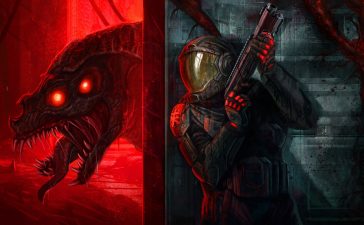
Bounce Arcade, recently announced and launching this Fall, looks like a unique fusion of pinball and VR, in a way that’s truly native to the medium. It’s an example of the body of VR-native gameplay mechanics that’s still in its infancy.
All video games trace their lineage to arcade games.
I’m not necessarily talking about games in a big cabinet, but any game which has little in the way of narrative, characters, and progression. They’re primarily built around mechanics that are just plain-old fun.
With Pong (1972) we figured out how one axis of input could work. With Pac Man (1980) we added two axes and enemies to chase the player. Super Mario Bros (1985) figured out how we would fit a larger and more complex world onto a small screen. And Star Fox (1993) on SNES laid the groundwork for navigating 3D worlds from a third-person perspective.
It’s the mechanics that drove these games—the ones that are so fun they don’t even need narrative, characters, or progression for them to feel complete.
It took 21 years to get from Pong to Star Fox. And since then, games have only grown in complexity, but only by building on core mechanics that were invented long before.
Platformers that are not conceptually distant from Super Mario Bros are still huge. So are games using third-person views and on-screen reticles for navigation and aiming.
I could go on-and-on with these examples, but the point is, they take time to figure out. And it’s not until you figure them out that you can create compelling games with all the other stuff on top, like narrative, characters, and progression.
It took decades of work to find these core mechanics and eventually turn them into the huge games we know and love today. But, all that work was done specifically for flatscreen games made for controllers or keyboards and mice.
When a new medium like VR comes along—with a whole new kind of input like 6DOF motion controllers—we can borrow from the flatscreen realm, but ultimately the medium needs to invent the mechanics that feel truly native to it.
Many VR games borrow too much from the world of flatscreen gaming. They don’t sufficiently answer the question ‘why play this in VR instead of on a flat screen?’. And these games tend not to find much commercial success.
Then something like Beat Saber comes along. Rhythm games have been around for a long time; but Beat Saber took the overall concept of a rhythm game and paired it with a core mechanic that is truly VR-native. The way you use your body to slice cubes in Beat Saber can’t be replicated in any medium other than VR.
Beat Saber found a core mechanic that feels great in VR. And one day that mechanic will be the foundation for a game that’s not just the arcadey expression of the mechanic, but a large and complex game instead.
There’s been other core VR mechanics discovered thus far. Like Gorilla Tag’s unique movement—which can’t be replicated outside of VR—that turned the simple game of tag into one of Quest’s most successful titles and spawned a whole new genre of games based on this VR-native mechanic.
But there’s still so much to invent and discover when it comes to VR-native mechanics.
All of this is to say, I love seeing new and creative gameplay ideas that feel truly at home in VR. And what I’ve seen of the recently announced Bounce Arcade immediately struck me as one of those ideas.
We’ve already seen plenty of pinball machine simulations in VR. The kind where you’re literally standing in front of a pinball machine and pressing buttons to flip the flippers.
But Bounce Arcade is taking the overarching concept of pinball and truly and creatively reimagining it for VR. Your fists are the paddles and the world around you is the playing field. It’s a fresh look at what pinball even means when you’ve got the power to alter the player’s entire reality and allow them to bring their hands into the game world.
Bounce Arcade is coming to Quest sometime this fall. So far pricing and other platforms are unconfirmed.
But this isn’t to say that all VR games are destined to be arcade games. To the contrary—what I’m saying is the medium still needs to spend time experimenting and innovating on core VR-native mechanics.
Only once a sufficient number of them are discovered and refined will we start to see a real mass of larger and more complex games that feel properly at home in VR. It’s actually pretty easy with a little imagination to see how you could extend Bounce Arcade’s underlying mechanic into a much more complex and less arcade-centric game.
And honestly, I think there are many more of these VR-native mechanics already out there that simply haven’t gotten enough attention. That’s a huge reason why I’m working on the Inside XR Design video series to highlight these kinds of learnings. If you’ve read this far, I have to imagine you’re interested enough in this topic that you’d probably enjoy checking out the episodes published so far.











